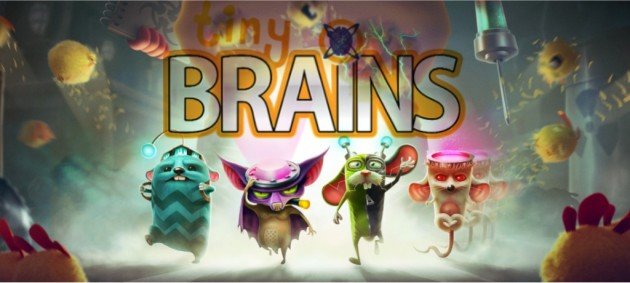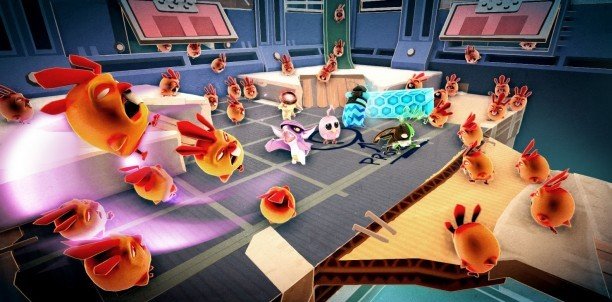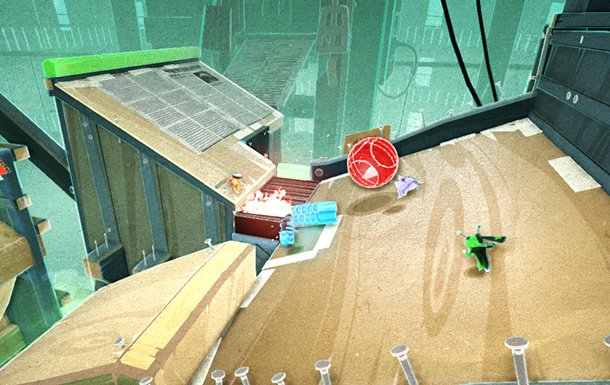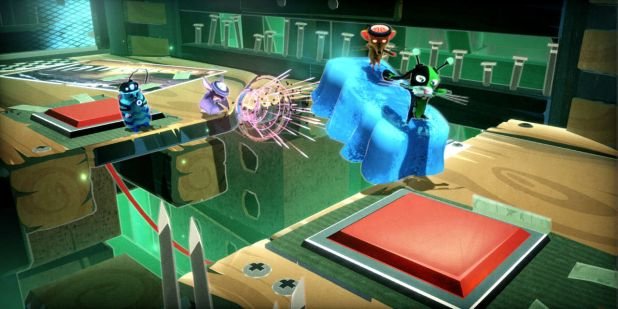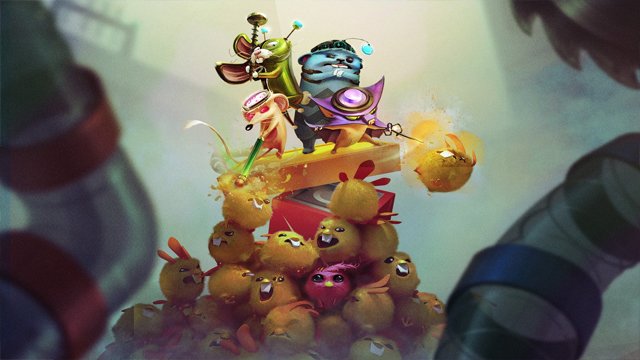Every now and then a game is made that forces co-op gameplay in hopes that it will bring back camaraderie that other games have forsaken. Where a game usually forces people to compete against one another, or where one player can do all the work leaving their “teammates” behind. Games where co-op isn’t only optional, but an actual necessity to complete a level, have been slightly amiss lately as many gamers wait for a rejuvenation of the genre. Tiny Brains is one such game, and it does succeed when it comes to great co-op gameplay, but only on the surface. Once you drive a little deeper, you realize the great experience is only in the beginning, and as time goes on, the game’s true shallowness arises.
The first thing you’ll notice about Tiny Brains are the adorable, yet somewhat disturbing, little creatures. The four little critters are all lab animals used for scientific tests. You know that classic run the rat through the maze to get to the cheese? It’s like that, only there are chain saws, fire, and radioactive powers this time. The four little critters must work together to survive the mad-scientist’s obstacles. Tiny Brains accomplishes something that I’ve only ever seen in the Portal franchise. There is something deeply disturbing about all the experiments, yet you laugh at the sadistically witty lines. The vibe fits pretty well, especially considering this is a puzzle game as well.
The main game is all about completing puzzles to progress through the level, with each section generally consisting of placing a battery in a certain hole, or pressing a certain switch. That is as basic as puzzlers come, but the difference in Tiny Brains is that the four creatures you play as have their own special power. The bat can push objects, the mouse can switch places with any object instantly, the rabbit can pull objects to him, and the hamster can create an ice-block to reach high areas. Separately, these powers aren’t all that great, and don’t do much good. Together, as one would expect, you can accomplish almost anything.
That’s pretty much the entire game, it’s a simple puzzler as you would expect. Now, it is certainly fun…at first. The first playthrough of the game was a blast as I tried to figure out puzzles with random people online. The chaos of working together and trying different strategies was entertaining to say the least. When you finally beat the level, it felt incredibly rewarding, and there was always a “nice job guys” between the players after each level. This is exactly the camaraderie that Tiny Brains was looking to accomplish, and it did succeed in that department. But did you notice how I said on my first playthrough?
There are only four main levels making Tiny Brains extremely short, I’m talking only a couple of hours at most here. The puzzles aren’t really that challenging, you’ll figure them out almost immediately, and at that point the only hindrance is trying to work with others to accomplish the task. I tried going back and playing the levels again, but since there is only one way to beat a puzzle there is no creativity. What ended up happening is a problem with most co-op puzzle games. Either you know how to solve the puzzle already, and instruct everyone else that you are playing with on how to complete it, which at that point it doesn’t feel like a game more like a manager ordering some underlings around. Or, the opposite, where someone else knows how to beat the level and they instruct you the entire time, in which case, you feel like you’re a small-time employee trying to appease the boss. The only time the game really shines is when everyone playing is experiencing the level for the first time, because that’s when the chaotic charm of Tiny Brains is revealed.
I thought the way the puzzles would change based on the number of people in the party would fix this problem. I was disappointed when I realized this wouldn’t be the saving grace Tiny Brains needs. I jumped into the middle of someone’s game, and he was the only person there. There was a bridge that would only rise in place if a switch was pressed, and when you play by yourself, the switch is timed. However, when I jumped in, the switch was no longer based off time, because there were now two people playing. That really meant I had to stand on the switch instead, which is exactly what I did. As I kept playing, we reached another area with another button. Once the button was pressed down, a platform moves, and the button was positioned down the entire time. That is, until a third person joined our game, then the button didn’t automatically stay down, but someone had to stand on it.
See where I’m going with this? Tiny Brains pretends like it’s something new every time for each playthrough, but a lot of the time it only takes two players to solve a puzzle, and the other players have to spend their time standing on switches. Tiny Brains needed to come up with a much more creative way to incorporate the number of people playing, because as it stands now, there is practically no incentive to replay through the story.
A wise move on the developers’ part to battle this lack of replay value, was incorporating challenge modes. This is truly where I spent most of my time. They are simple challenges, some puzzle ones that require a lot of thinking, but by far the best ones involve moving that damn ball. There are multiple sections in the main story where everyone needs to work together to move a ball from point A to B. These sections are the most frustrating and also the most entertaining parts of the game. There are a few challenges that involve trying to get the ball to either go the longest, or last the longest. It’s a simple premise that is highly addicting.
I didn’t think I would spend so much time on these challenges, but they turned out to be the most fun. They always start off with complete chaos, as every players tries to move the ball as quickly as possible. Slowly, each player learns their role, even without speaking to one another, a well-organized team is formed. I played with a lot of different people during these ball challenges, and this happened every time. Once again, it’s a rewarding feeling when the first time you worked together it was chaos and the ball barely went anywhere. Versus ten minutes later, when everyone is a well-oiled machine working in perfect unison. Still in the end, this mode grows repetitive as well, and will only keep your attention for so long.
Tiny Brains is a nice idea, but it isn’t long or diverse enough. The puzzles alone are repetitive: move a block here, press a switch here, and the powers are used in the same way every time. Once you get a grasp on the game, it becomes easy to solve the puzzles, except for working with others, which can either be fun, frustrating, or boring depending on if someone already knows the solution. Tiny Brains is simply too short to have any lasting appeal, and even though the challenge modes are addicting, they grow old after thirty minutes or so. Even just a week later, I’m finding it almost impossible to join a game with other players, as if everyone has gotten bored with it and moved on already. You can play by yourself; of course, but the fun comes from playing with others. In fact, I’m not really finding myself wanting to go back to it either, and the game is still fairly new. When it comes down to it Tiny Brains is a fun game with friends, but technically anything is fun with friends, even a bad game.
This review is based off of a review code of the Playstation 4 version of Tiny Brains developed and published by Spearhead Games.
- Fun Co-Op
- Challenge Modes
- Little Replay Value
- Too Short

